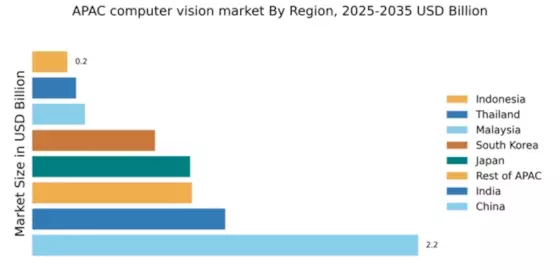China : Unmatched Growth and Innovation
China holds a commanding 2.2% market share in the APAC computer vision sector, driven by rapid advancements in AI and machine learning technologies. The government's strong support for tech innovation, coupled with significant investments in smart city initiatives, fuels demand. Regulatory frameworks are increasingly favorable, promoting the integration of computer vision in various sectors, including healthcare and manufacturing. Infrastructure development, particularly in urban areas, enhances the deployment of these technologies.
India : Rapid Growth and Adoption
India's computer vision market is valued at 1.1%, reflecting a burgeoning interest in AI applications across industries. Key growth drivers include a young, tech-savvy population and increasing smartphone penetration. Government initiatives like Digital India promote the adoption of advanced technologies, while investments in infrastructure support the growth of tech startups. The demand for computer vision in sectors such as agriculture and retail is on the rise, driven by the need for automation and efficiency.
Japan : Strong R&D and Market Potential
Japan's computer vision market, valued at 0.9%, is characterized by its robust research and development ecosystem. The country is witnessing a surge in demand for AI-driven solutions, particularly in robotics and automotive sectors. Government policies encourage innovation, with initiatives aimed at enhancing AI capabilities. The aging population also drives the need for automation in healthcare, creating a favorable environment for computer vision technologies.
South Korea : Leading in AI Applications
South Korea's computer vision market stands at 0.7%, bolstered by strong government support for AI and smart technologies. The country is a leader in integrating computer vision into consumer electronics and automotive industries. Initiatives like the Korean New Deal aim to enhance digital infrastructure, fostering innovation. Major cities like Seoul and Busan are key markets, with significant investments from local giants like Samsung and LG, driving competitive dynamics in the sector.
Malaysia : Strategic Investments in Technology
Malaysia's computer vision market is valued at 0.3%, with increasing demand driven by sectors such as manufacturing and agriculture. The government’s initiatives, including the Malaysia Digital Economy Blueprint, promote the adoption of AI technologies. Infrastructure improvements and a focus on digital transformation are key growth factors. The market is characterized by a mix of local startups and international players, creating a dynamic competitive landscape.
Thailand : Focus on Industrial Automation
Thailand's computer vision market, valued at 0.25%, is experiencing growth due to rising automation in manufacturing and logistics. Government policies support the Industry 4.0 initiative, encouraging the integration of advanced technologies. Key cities like Bangkok and Chiang Mai are pivotal markets, with a growing number of tech startups. Major players, including international firms, are establishing a presence, enhancing the competitive environment in the region.
Indonesia : Investments in Digital Transformation
Indonesia's computer vision market is valued at 0.2%, with significant potential for growth driven by increasing smartphone usage and digitalization efforts. Government initiatives aimed at enhancing the digital economy are fostering a conducive environment for tech adoption. Key cities like Jakarta are central to market activities, with a mix of local and international players competing for market share. The demand for computer vision in sectors like retail and agriculture is on the rise.
Rest of APAC : Varied Market Dynamics and Growth
The Rest of APAC region holds a market share of 0.91%, showcasing diverse opportunities across various countries. Growth is driven by increasing investments in technology and infrastructure development. Countries like Vietnam and the Philippines are emerging as key players, with government support for tech innovation. The competitive landscape is characterized by a mix of local startups and established international firms, creating a dynamic market environment.


















Leave a Comment